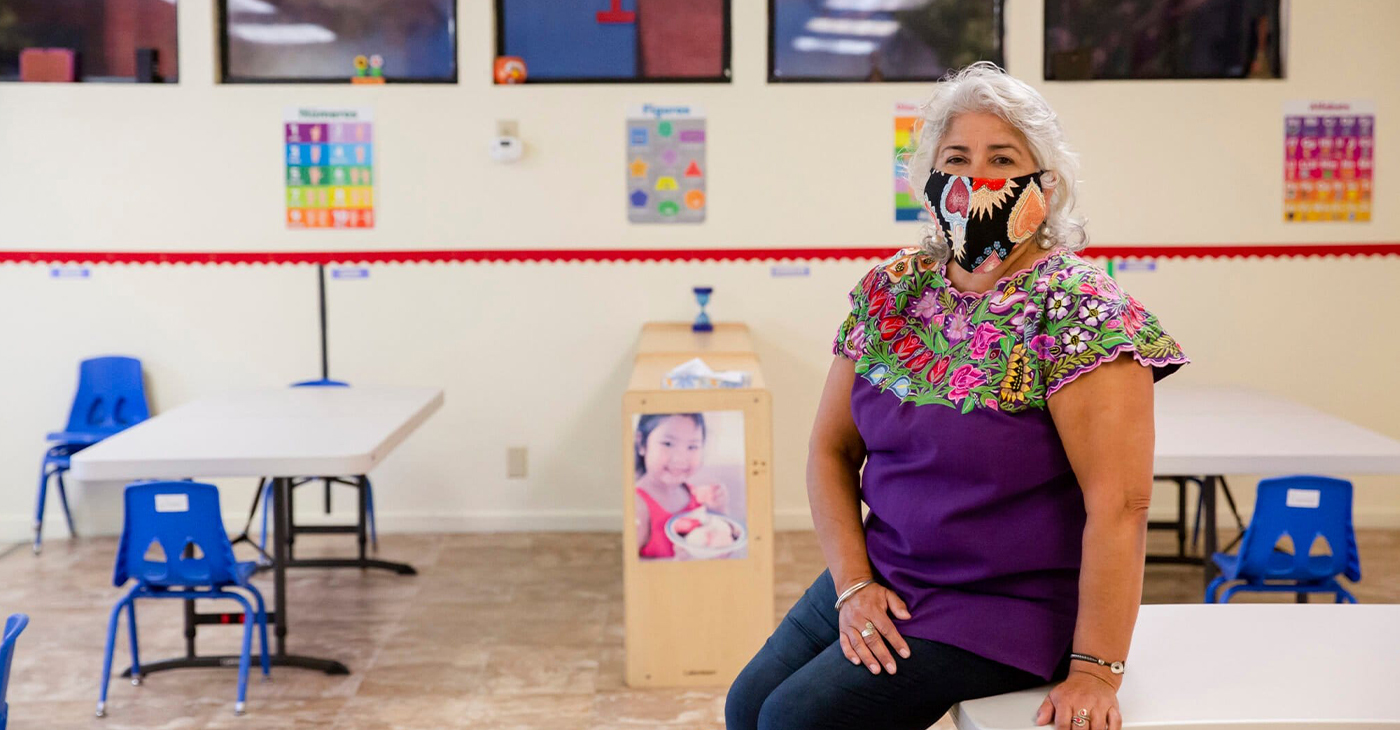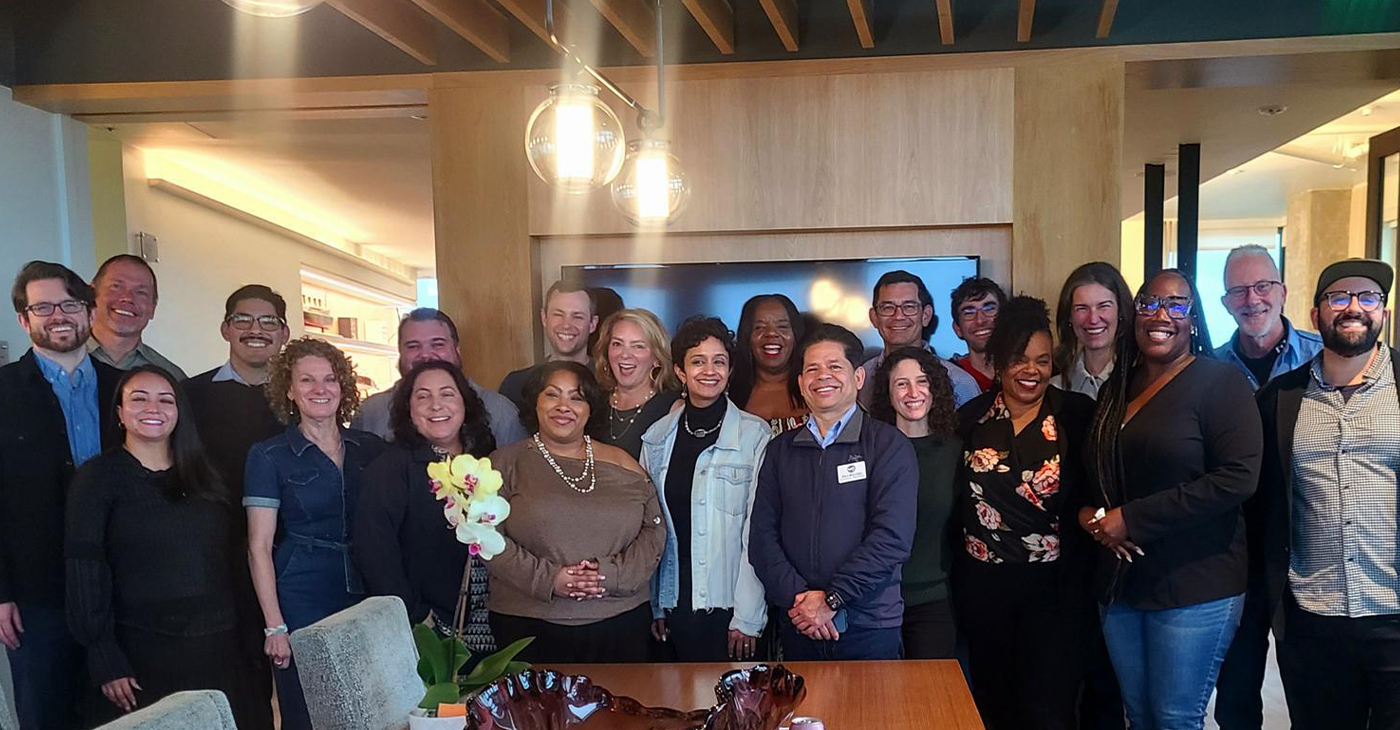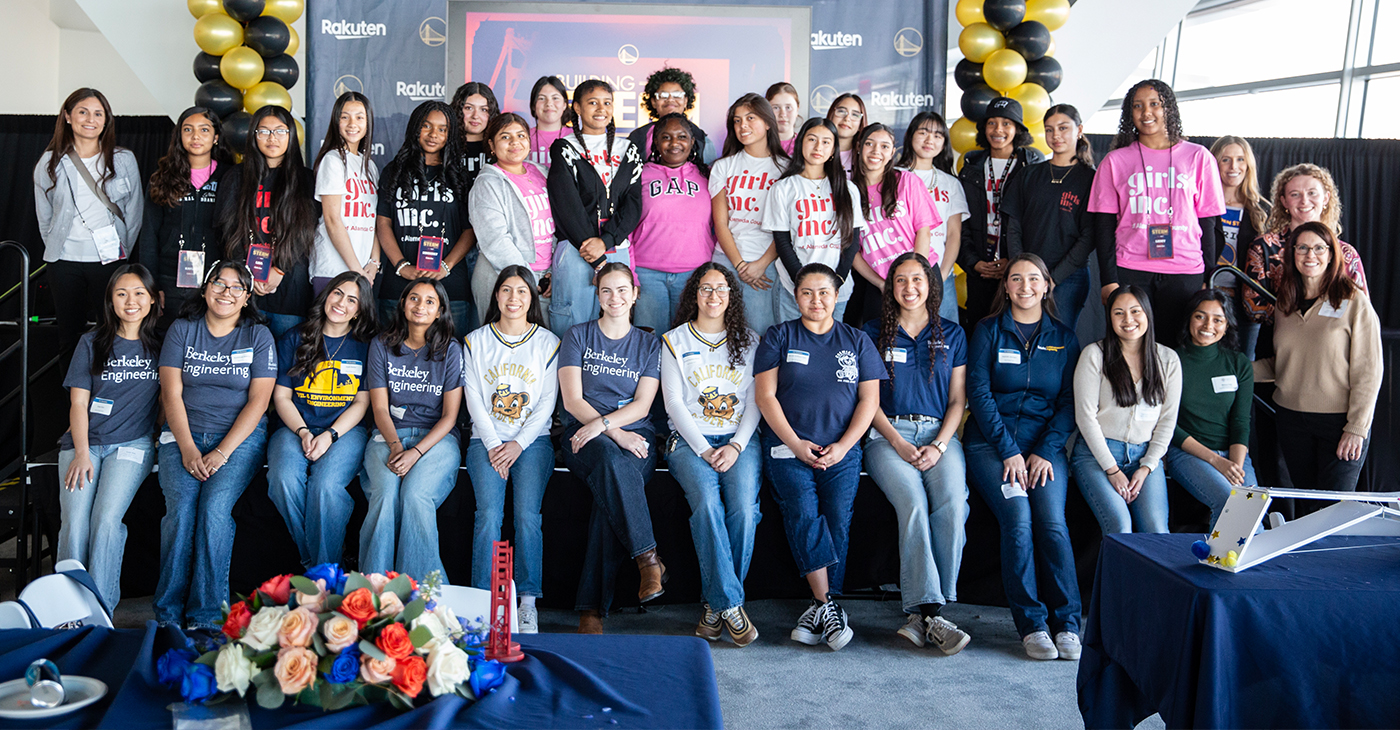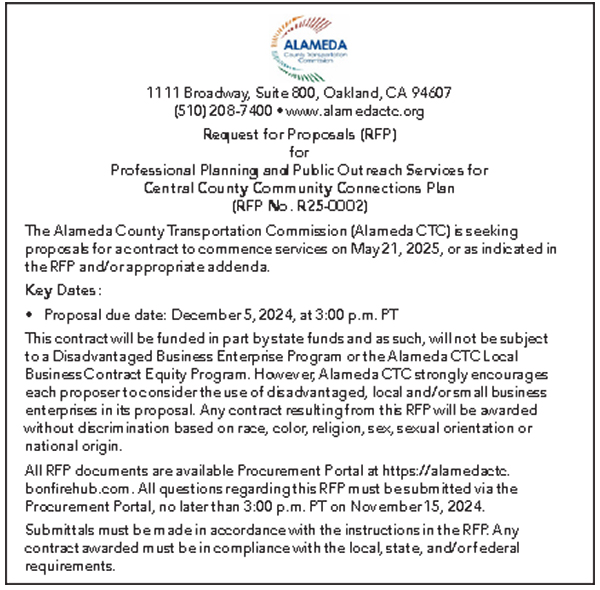Education
Castlemont High Students Prepare for Trip to Vietnam and Cambodia


Shown are social studies teacher Jonathan Guy (top row, second from right) and stShown are social studies teacher Jonathan Guy (top row, second from right) and students who belong to the Pacific Bridge Club at Castlemont High School. Students are wearing cancer awareness T-shirts.
Everyone loves a field trip; museums take on new appeal to those who might not visit them otherwise; historical sights and trips to City Council meetings are very attractive to most students and often have a lasting impact on students.
Castlemont High School Economics and Government teacher Jonathan Guy is pushing this kind of hands-on experience to a higher level with his effort to take 35 students to Vietnam and Cambodia for two weeks after a similar successful trip last spring to China with a group of 16 boys.
Students chose these locations after studying a map of Asia and the Middle East.
Guy himself has lived in China and speaks Mandarin, at about a “6th or 7th grade level,” he says.
His wife has family in Cambodia. He first developed an interest in China when taking a Chinese history class while attending Cal State East Bay. He began teaching Western Culture in Beijing at the Anhue University College of Economics, spending three years there before returning to the Bay Area.
After taking a job in the Oakland Unified School District, the idea came to him to take students abroad to a place he knew well. But beyond that, Guy said, he felt students needed more than just a chance to travel.
“When I was growing up (in Pittsburgh), I had role models,” but some of his friends, whose fathers were absent, died violently or wound up incarcerated, he said. “I felt that students needed to step up their game. What better way to do that than having an experience abroad?”
With that in mind, he created the Pacific Bridge Club, (PBC) to “use community events, culture building, and traveling as avenues (to allow) our youth to have a foreign experience of traveling to developing countries so that they can return with a different outlook on life to improve their lives and our communities,” according to the group’s mission statement.
After the trip to China last spring (2018), he saw almost every one of the students who went on that trip change in positive ways. Guy said he saw a certain wisdom emerge.
To participate in the club, students must maintain a minimum standard of behavior throughout their classes; including no more than three detentions in one semester, remaining on track to graduate and maintaining a minimum 2.0 average, as well as refraining from oppressive language and attending meetings.
The meetings begin with a setting of the norms, around respect, attitude and focus; as students read each one aloud. The day this reporter met with them, almost all were wearing their pink cancer awareness Tshirts that are part of the work of the PBC; to each month raise awareness about a different social issue or cause.
The overseas trip is the culmination of a nearly year-long program of discussion, community engagement projects and mandatory meeting attendance every Tuesday and Thursday.
Students must demonstrate they can work together. Since beginning in August, students have worked on raising awareness for sickle cell anemia, police brutality and cancer.
Some of the young people have never been on an airplane or out of the U.S.
On the trip last school year, students were chaperoned by other staff, including Assistant Principal Michael Scott, Digital Arts teacher Nathan Burks and Restorative Justice coordinator Frankie Navarro.
Students were encouraged to be on their best behavior. They were asked: “Who are you representing?” How does it reflect on your family?”
Angela, a senior at CHS, said her main reason for wanting to be part of PBC is because I think it’s important for young people to be a part of something bigger themselves, and helping other people.”
Another girl, Monday, also a senior, said, “I’m a new student at Castlemont; before I came here, I was getting in a lot of conflict and trouble; Mr. Guy told me about the opportunity, what they do and why and how they do it…It just really inspired me to do something positive with my life.”
Senior JP (John Paul) mentioned both the China trip and a subsequent trip to visit family in the Philippines. “I came back with a deep sense of humility,” he said, referring to where his grandmother lives not far from homeless encampments of entire families.
Senior Rufino, who went on the China trip noted that his travels “changed my perspective on how people act; respect is seen differently in different cultures, it made me think about things, treating people with more respect.”
For more information or to support the upcoming trip of Castlemont High School students to Cambodia and Vietnam, go to Pacific Bridge Club or Mr. Guy’s Classroom
Bay Area
Five Years After COVID-19 Began, a Struggling Child Care Workforce Faces New Threats
Five years ago, as COVID-19 lockdowns and school closures began, most early educators continued to work in person, risking their own health and that of their families. “Early educators were called essential, but they weren’t provided with the personal protective equipment they needed to stay safe,” said CSCCE Executive Director Lea Austin. “There were no special shopping hours or ways for them to access safety materials in those early and scary months of the pandemic, leaving them to compete with other shoppers. One state even advised them to wear trash bags if they couldn’t find PPE.”

UC Berkeley News
In the first eight months of the COVID-19 pandemic alone, 166,000 childcare jobs were lost across the nation. Significant recovery didn’t begin until the advent of American Rescue Plan Act (ARPA) Child Care Stabilization funds in April 2021.
Today, child care employment is back to slightly above pre-pandemic levels, but job growth has remained sluggish at 1.4% since ARPA funding allocations ended in October 2023, according to analysis by the Center for the Study of Child Care Employment (CSCCE) at UC Berkeley. In the last six months, childcare employment has hovered around 1.1 million.
Yet more than two million American parents report job changes due to problems accessing child care. Why does the childcare sector continue to face a workforce crisis that has predated the pandemic? Inadequate compensation drives high turnover rates and workforce shortages that predate the pandemic. Early childhood educators are skilled professionals; many have more than 15 years of experience and a college degree, but their compensation does not reflect their expertise. The national median hourly wage is $13.07, and only a small proportion of early educators receive benefits.
And now a new round of challenges is about to hit childcare. The low wages paid in early care and education result in 43% of early educator families depending on at least one public support program, such as Medicaid or food stamps, both of which are threatened by potential federal funding cuts. Job numbers will likely fall as many early childhood educators need to find jobs with healthcare benefits or better pay.
In addition, one in five child care workers are immigrants, and executive orders driving deportation and ICE raids will further devastate the entire early care and education system. These stresses are part of the historical lack of respect the workforce faces, despite all they contribute to children, families, and the economy.
Five years ago, as COVID-19 lockdowns and school closures began, most early educators continued to work in person, risking their own health and that of their families. “Early educators were called essential, but they weren’t provided with the personal protective equipment they needed to stay safe,” said CSCCE Executive Director Lea Austin. “There were no special shopping hours or ways for them to access safety materials in those early and scary months of the pandemic, leaving them to compete with other shoppers. One state even advised them to wear trash bags if they couldn’t find PPE.”
The economic impact was equally dire. Even as many providers tried to remain open to ensure their financial security, the combination of higher costs to meet safety protocols and lower revenue from fewer children enrolled led to job losses, increased debt, and program closures.
Eventually, the federal government responded with historic short-term investments through ARPA, which stabilized childcare programs. These funds provided money to increase pay or provide financial relief to early educators to improve their income and well-being. The childcare sector began to slowly recover. Larger job gains were made in 2022 and 2023, and as of November 2023, national job numbers had slightly surpassed pre-pandemic levels, though state and metro areas continued to fluctuate.
Many states have continued to support the workforce after ARPA funding expired in late 2024. In Maine, a salary supplement initiative has provided monthly stipends of $240-$540 to educators working in licensed home- or center-based care, based on education and experience, making it one of the nation’s leaders in its support of early educators. Early educators say the program has enabled them to raise wages, which has improved staff retention. Yet now, Governor Janet Mills is considering cutting the stipend program in half.
“History shows that once an emergency is perceived to have passed, public funding that supports the early care and education workforce is pulled,” says Austin. “You can’t build a stable childcare workforce and system without consistent public investment and respect for all that early educators contribute.”
The Center for the Study of Childcare Employment is the source of this story.
Activism
District Delegates to State Democratic Party Central Committee Meeting Celebrate Election Victory
Delegates and elected officials were excited for the future of the Democratic Party and making its focus on 1) creating more affordable housing, 2) supporting education, 3) helping working families, and 4) protecting the environment and addressing climate change, with a focus on practical and realistic policy efforts that could have a meaningful impact.

By Ben Gould
Special to The Post
Winners of the February 2025 Assembly District Election Meetings (ADEM) for Assembly Districts 14 and 18 met on Sunday, March 16 to discuss priorities for the California Democratic Party convention in Anaheim coming up in May.
The winners for Assembly District 18 are Genice Jacobs, Bobbi Lopez, Shawn Danino, Ben Gould, Zac Bowling, Nate Hanson, Cathy Adams, Sam Gould, Lauren Wilson, Ashlee Jemmott, and former Oakland School Board Director Sam Davis.
The winners for Assembly District 14 are: Sarah Bell, Neil Tsutsui, Hercules Councilmember Dilli Bhattarai, former Berkeley School Board Director Laura Babitt, former Piedmont Mayor Teddy Gray King, and former Albany Mayor Nick Pilch.
They were joined by Oakland Councilmember Janani Ramachandran, Emeryville Councilmember Courtney Welch, and BART Director Victor Flores to help celebrate their victory.
Delegates and elected officials were excited for the future of the Democratic Party and making its focus on 1) creating more affordable housing, 2) supporting education, 3) helping working families, and 4) protecting the environment and addressing climate change, with a focus on practical and realistic policy efforts that could have a meaningful impact.
Activism
Golden State Warriors Program Is Inspiring Next Generation of Female Engineers
Breaking down barriers and biases that deter young girls from pursuing STEAM subjects is essential for creating a level playing field and ensuring equal opportunities for all. By challenging stereotypes and promoting a culture of inclusivity and diversity in STEAM fields, experts believe young girls can be empowered to pursue their interests and aspirations without limitations confidently. Encouraging mentorship, providing access to resources, and celebrating girls’ achievements in STEAM are all crucial steps in creating a supportive environment that fosters success.

By Y’Anad Burrell
The Golden State Warriors and e-commerce giant Rakuten are joining forces to inspire the next generation of female engineers through Building STEAM Futures, part of The City Calls campaign.
Organizers say the initiative is founded on the idea that science, technology, engineering, arts, and mathematics (STEAM) are crucial fields for innovation and progress, and empowering young girls to pursue careers in these areas is more important than ever. Studies consistently show that girls are underrepresented in STEAM fields, resulting in a gender disparity that limits potential and hinders diversity.
Breaking down barriers and biases that deter young girls from pursuing STEAM subjects is essential for creating a level playing field and ensuring equal opportunities for all. By challenging stereotypes and promoting a culture of inclusivity and diversity in STEAM fields, experts believe young girls can be empowered to pursue their interests and aspirations without limitations confidently. Encouraging mentorship, providing access to resources, and celebrating girls’ achievements in STEAM are all crucial steps in creating a supportive environment that fosters success.
On Saturday, March 8, International Women’s Day, the Warriors and Rakuten hosted 20 middle school girls from Girls Inc. of Alameda County at Chase Center’s Above the Rim for a hands-on bridge-building experience. The young girls from Girls, Inc. of Alameda County had an opportunity to design, build and test their own bridge prototypes and learn the fundamentals of bridge construction from the Engineering Alliance and the UC Berkeley Steel Bridge Team.
This STEAM experience for the girls followed the first session in January, where they took a behind-the-scenes tour of the Golden Gate Bridge, learning about its design and construction from industry experts. The City Calls campaign, tipped off with the unveiling the Warriors’ new bridge-themed City Edition jerseys and court design earlier this year.
-

 Activism4 weeks ago
Activism4 weeks agoWe Fought on Opposite Sides of the Sheng Thao Recall. Here’s Why We’re Uniting Behind Barbara Lee for Oakland Mayor
-

 Activism4 weeks ago
Activism4 weeks agoFaith Leaders Back Barbara Lee for Mayor, Criticize Candidate Loren Taylor for Dishonest Campaigning
-

 Activism3 weeks ago
Activism3 weeks agoOakland’s Most Vulnerable Neighborhoods Are Struggling to Eat and Stay Healthy
-

 #NNPA BlackPress4 weeks ago
#NNPA BlackPress4 weeks agoRev. Dr. Jamal Bryant’s Black Church Target Boycott Mobilizes 150,000
-

 #NNPA BlackPress4 weeks ago
#NNPA BlackPress4 weeks agoRecently Approved Budget Plan Favors Wealthy, Slashes Aid to Low-Income Americans
-

 Activism2 weeks ago
Activism2 weeks agoOakland Post Endorses Barbara Lee
-

 Activism4 weeks ago
Activism4 weeks agoGroup Takes First Steps to Recall District Attorney Diana Becton
-

 Activism4 weeks ago
Activism4 weeks agoOakland Post: Week of March 19 – 25, 2025










































